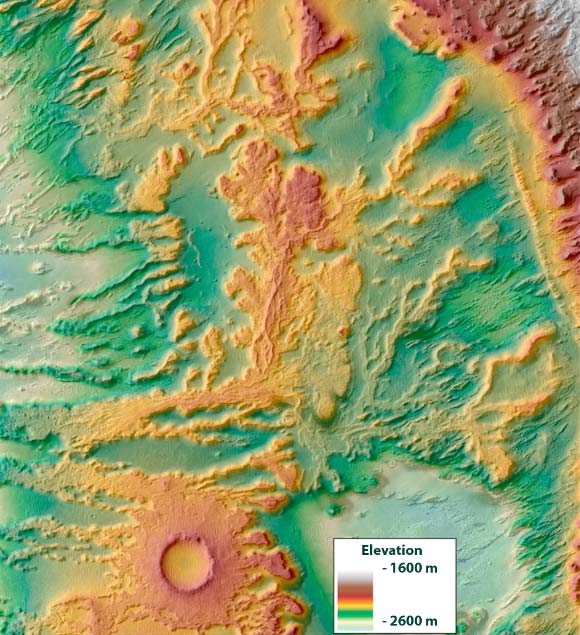A study published in the June issue of the Journal of Geophysical Research: Planets (full paper in .pdf) provides new evidence that an ocean covered as much as one third of the Martian surface early in its history.

This shaded relief map shows elevated, branching, lobate features in Aeolis Dorsa, Mars, interpreted as resistant channel deposits that make up an ancient delta. These layered, cross-cutting features are typical of channelized sedimentary deposits on Earth and here are indicative of a coastal delta environment (Roman A. DiBiase et al)
Most of the planet’s northern hemisphere is flat and at a lower elevation than the southern hemisphere, and thus appears similar to the ocean basins found on Earth. The border between the lowlands and the highlands would have been the coastline for the hypothetical ocean.
Planetary scientists at California Institute of Technology in Pasadena used new images from the Mars Reconnaissance Orbiter to study a 100-square-km area that sits right on this possible former coastline.
Previous satellite images have shown that this area – part of a larger region called Aeolis Dorsa, which is about 1,000 km away from Gale Crater where the Curiosity rover is now roaming – is covered in ridge-like features called inverted channels. These inverted channels form when coarse materials like large gravel and cobbles are carried along rivers and deposited at their bottoms, building up over time. After the river dries up, the finer material – such as smaller grains of clay, silt, and sand—around the river erodes away, leaving behind the coarser stuff. This remaining sediment appears as today’s ridge-like features, tracing the former river system.
When looked at from above, the inverted channels appear to fan out, a configuration that suggests one of three possible origins: the channels could have once been a drainage system in which streams and creeks flowed down a mountain and converged to form a larger river; the water could have flowed in the other direction, creating an alluvial fan, in which a single river channel branches into multiple smaller streams and creeks; or the channels are actually part of a delta, which is similar to an alluvial fan except that the smaller streams and creeks empty into a larger body of water such as an ocean.
The scientists analyzed the stratigraphic layers of the inverted channels, piecing together the history of how sediments were deposited along these ancient rivers and streams. They were able to determine the slopes of the channels back when water was still coursing through them. Such slope measurements can reveal the direction of water flow – in this case, showing that the water was spreading out instead of converging, meaning the channels were part of an alluvial fan or a delta. But they also found evidence for an abrupt increase in slope of the sedimentary beds near the downstream end of the channels. That sort of steep slope is most common when a stream empties into a large body of water – suggesting that the channels are part of a delta and not an alluvial fan.
Scientists have discovered deltas on Mars before, but most are inside a geological boundary, like a crater. Water therefore would have most likely flowed into a lake enclosed by such a boundary and so did not provide evidence for an ocean. But the newly discovered delta is not inside a crater or other confining boundary, suggesting that the water likely emptied into a large body of water like an ocean.
“This is probably one of the most convincing pieces of evidence of a delta in an unconfined region – and a delta points to the existence of a large body of water in the northern hemisphere of Mars,” said lead author Dr Roman DiBiase.
“This large body of water could be the ocean that has been hypothesized to have covered a third of the planet. At the very least, the water would have covered the entire Aerolis Dorsa region, which spans about 100,000 square km.”
______
Bibliographic information: Roman A. DiBiase et al. 2013. Deltaic deposits at Aeolis Dorsa: Sedimentary evidence for a standing body of water on the northern plains of Mars. Journal of Geophysical Research: Planets, vol. 118, no. 6, 1285–1302; doi: 10.1002/jgre.20100







